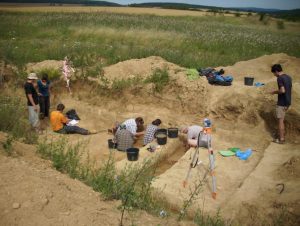Paleoclimatic changes
Paleoclimatic changes
as one of the factors influencing patterns of behaviour and adaptability of human society
Based on the up to date available paleoenvironmental proxy- data portfolio obtained from archaeological features and its analyses, it seems that many cultural and historical changes in human history were not caused just by transformations and tensions in human societies, but that these often radical breaks in human patterns of behaviour and adaptability were caused by human reactions on outer stimuli in a form of environmental, mainly climatic changes (either temporal oscillations or distinct long-term turns), but also in a form of water regime changes, exhaustion of raw material and other sources etc. It is symptomatic, that these changes, in archaeology connected with the beginnings of new historic periods, usually occur during palaeoecological breaks. These breaks are to be detected during periods of transformations of prehistoric societies, such as turns of Middle Palaeolithic and Upper Palaeolithic, Late Palaeolithic/Mesolithic, Mesolithic/Neolithic, Neolithic/Eneolithic and Eneolithic/Bronze Age. Among the main topics of this project, it is possible to mention an analysis of the relationship between the climate and patterns of human behaviour and adaptations, raw material procurement strategies, subsistence systems and technologies (genesis of technologies, impact of technological development etc.), symbols, structures, limits, changes, causes and consequences of human behaviour as a reflection of external (environmental) changes, which are dominated by a climate change.
The main aim of this project is to verify a hypothesis about a crucial influence of climate changes on human societies in selected Central European regions. In which forms, models and structures does this influence appear? Are there any regional differences? These research questions will be answered on a base of a collecting, analysing and interpretation of a variety of proxy-data obtained by modern interdisciplinary research of selected sites. Reliable proxy-data procurement (such as carbon, nitrogen, oxygen and strontium isotopes, archaeobotanical, paleoenvironmental and archaeogenetic data, absolute chronology etc.) from the end of one period and from the beginning of the other is a method, how to prove climatic and other environmental changes in a context of a change in settlement and funeral areas, settlement strategies etc. Subsequently it is possible to pay attention to subsistence strategies and economic systems in a span of time on a background of superstructure phenomena detected in an archaeological record. Finally, the hypothetical models and paradigms connected with the rules of prehistoric society development will be defined and tested. Main attention will be focused on turning points in prehistory, such as the Early Upper Palaeolithic with its technological innovations and a development of aesthetic feeling and spiritual life, Late Palaeolithic to Mesolithic transition and a human society adaptation to climate and environmental change in a context of the beginning of Holocene, transformation of foragers into agriculturalists with all attributes of the Neolithisation, or Neolithic/Eneolithic and Eneolithic/Bronze Age transformations. Only a detailed and complex research of these periods can produce sufficiently wide spectrum of proxy-data and also possibilities of their interpretation and explanation in a high quality and quantity. These results will lead to a procurement of a vivid picture of researched phenomena and they will also guarantee the maximal possible degree of objectivity necessary for its correct interpretation.
Results of this project will document an influence of climate and environmental changes on a human society in a prehistory of Central Europe, which will enable a comparison with other regions. The scientific publications published in impacted journals, as well as popular lectures and exhibitions will be among the main outputs of this project. Comprehension of the principles of mutual influencing of climate, environment and human society is, in regard of current climate change, one of the key scientific topics.

Archaeological excavation of the Želeč site in the area of the Ondratice gravel mine in Central Moravia. Several hearths and lithic artefacts excavated on this site were dated to the beginning of the Upper Palaeolithic (approximately 43 000 years BP cal). Photo by O. Mlejnek.

Photograph of lithic tools found during the archaeological excavation of the Městec/Ostrov site near the Uhersko train station in eastern Bohemia. Based on the radiocarbon dating of the charcoal pieces found on this site, this settlement was dated back to the beginning of the Mesolithic (Preboreal period, circa 11 250 years BP cal). a – backed bladelets, b – burins, c – end scrapers, d – retouched triangles. Photo by M. Kršková.





